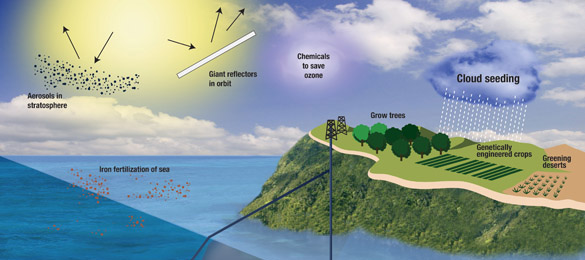ENVIRONMENT: CLIMATE
To engineer or not to engineer?
MIT political science panel assesses benefits/uncertainties of climate engineering plans

"The most serious obstacles to the use of
climate engineering are political. In addition,
any global climate engineering initiative
will inevitably raise international issues."
As the human and economic costs of climate change threaten to rise — and with little progress in reducing global carbon emissions — some scientists, activists, and political leaders are searching for new ways to respond to the global climate crisis. On October 30, 2013, MIT hosted a panel with David Keith a Harvard scientist and geoengineer, along with with MIT political scientists Kenneth Oye and Stephen Van Evera, to discuss the prospect of climate engineering — a set of controversial strategies to cool the earth’s climate with technological interventions. The event was co-sponsored by the MIT Political Science Department and Boston Review.
What is climate engineering?
Most simply put: "Climate engineering is a form of geoengineering — a deliberate, large-scale intervention in the Earth’s climatic system with the aim of reducing global warming. Climate engineering has two categories of technologies — carbon dioxide removal and solar radiation management."
MIT Professors David Keith and Kenneth Oye each pointed out that the scientific understanding of climate engineering has remained mostly unchanged for several decades due to lack of interest and investment. Keith argues that there is a need for more experimental research before the necessary large-scale implementation can take place.
Keith’s proposal — outlined in his new book, A Case for Climate Engineering (MIT Press, 2013) — focuses on one proposed method in particular: injecting sulfur into the atmosphere to reduce the rate of global warming. Sulfur bonds with water molecules in the atmosphere, and these sulfates reflect solar radiation. Practically, he says, this proposal would involve commercial jetliners pumping sulfur into the upper atmosphere, at a very small cost to the global community.
This method has worked before, Keith explained, although not because of any human activity. Volcanic eruptions in the past added sulfur to the atmosphere, reducing the global temperature. As a result, scientists have a large amount of data on the effect of atmospheric sulfur on solar radiation, the ozone, and global health.
What are the benefits?
Keith argued that other methods of reducing carbon output will have minimal effect within the lifetimes of those making the economic/political sacrifices to effect the reduction. It will take centuries, he says, of carbon emission reduction to reverse the current climate conditions. “The climate change you’re seeing today isn’t the cause of carbon emission over the past few years,” he said. “It’s the result of emissions from fifty to one hundred years ago.”
This time lag is also why passing carbon reduction policy is challenging. What’s needed today is a tool that will slow climate change in the near-term, and also pair with long-term emission reduction strategies. Atmospheric sulfur, Keith postulated, could be that tool. Reducing the rate of global warming would counteract some of the immediate effects of climate change — meaning that today’s politicians and their constituents will receive some benefit from the efforts and sacrifices they make.
One audience member, an MIT faculty member in chemistry, pointed out that there are serious aspects of climate change, such as ocean acidity, which are not addressed by this method. Atmospheric sulfur could also unintentionally lower society's drive to reduce carbon emissions by mitigating the effects, he said. Several in the audience agreed. Keith and Oye responded that this is a pitfall to be avoided at all costs. The point of any short-term alleviation, Keith said, would be to control carbon emissions over the long term.
What are the problems?
According to Keith, the most serious obstacles to the use of climate engineering are political. Funding is needed for further research, but for economic and political reasons, does not appear to be forthcoming. In addition, any global climate engineering initiative will inevitably raise international issues. All three panelists agreed there is no governing body with the legitimacy to pursue such a global endeavor.
Several audience members asked questions probing the issue of unilateral action. The cost of adding sulfur to the atmosphere is so low it would be easy for a single nation or an independent philanthropist to spearhead. All three panelists found this idea plausible, but unlikely. Breaching the sovereignty of another country by implementing a global geo-engineering program poses too great a risk for nations and individuals alike.
There are also the uncertainties, the “unknown unknowns” Oye said. Atmospheric sulfur might have unforeseen long-term consequences. Keith noted that this need not halt exploratory research, however. “That’s what technology does,” he said. “Each new technology addresses problems presented by previous technologies.”
As one MIT undergraduate said following the event, there are no easy answers — but this is a discussion to be continued.
Suggested links
Video of Panel Discussion | MIT Tech TV
Washington Post | Global convention considers limits on climate engineering
Story prepared by MIT SHASS Communications
Editorial and Design Director: Emily Hiestand
Writers, Daniel Pritchard, Kierstin Wesolowski , Emily Hiestand
Image credit: U.S. Department of Energy